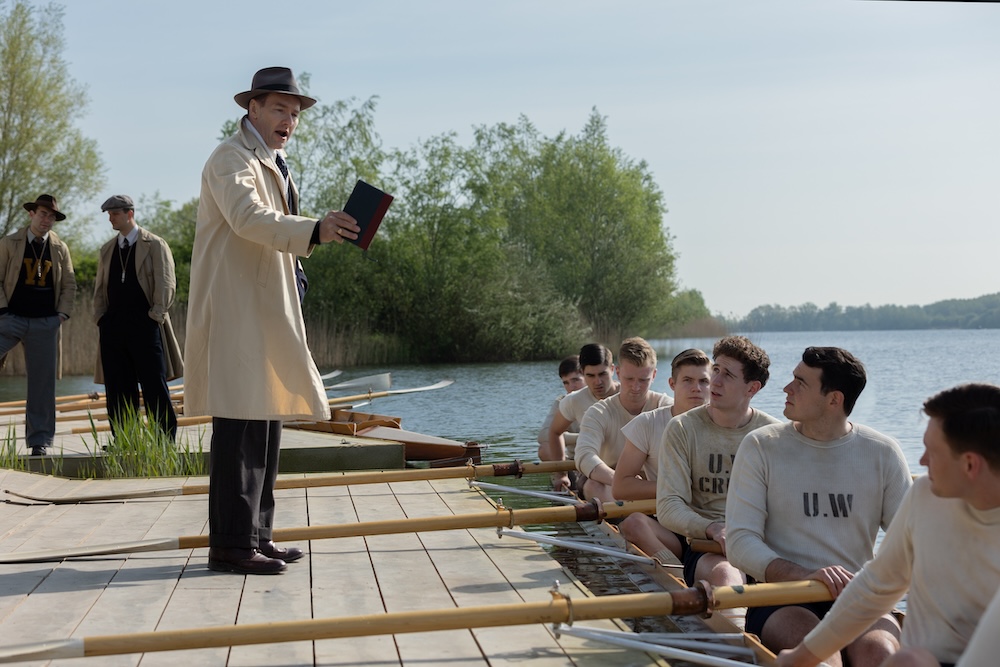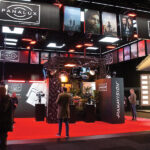
Blades of glory: The Boys in the Boat
Posted on Feb 12, 2024 by Katie Kasperson
The Boys in the Boat, George Clooney’s latest foray into directing, tells the true story of the University of Washington-turned-United States Olympic rowing team. To capture their epic journey, DOP Martin Ruhe took to the water
Words Katie Kasperson
Based on the 2013 novel by Daniel James Brown, The Boys in the Boat follows the University of Washington (UW) men’s rowing team in the lead-up to the 1936 Berlin Olympics. As its name suggests, the film largely takes place on the water – a challenge tackled by cinematographer Martin Ruhe.
Directed by industry veteran George Clooney, The Boys in the Boat is a true tale of emotional and athletic grit during the Great Depression. “He was fascinated by the story, by the book,” recounts Ruhe, who collaborated with Clooney on previous projects such as Catch-22. “He loved the underdog thing.” Ruhe wasn’t familiar with The Boys in the Boat when Clooney initially asked him to join the project, but he quickly became fascinated after reading the story. “I never thought that rowing would have such an audience,” he admits.
UP TO THE TASK
Ruhe had some experience with shooting on the water, but ‘never to the extent’ of what appears in The Boys in the Boat. “I’d never shot a rowing race before; it’s very specific. Rowing is a weird sport because all the rowers move. It’s hard to capture and not that expressive,” he continues. The boats are sensitive to waves and wind, while the oars prevent camera boats from getting too close. “You can only shoot from certain angles, which makes it quite complicated.”
Ruhe was also initially at a loss regarding external references to rowing. “I tried to find imagery, but there’s not that much out there,” he remarks. “There’s a little sequence in The Social Network, but that’s only a minute. I think our final boat race is eight minutes, and we have other boat races which are really long. So it was hard to find something.”
Eventually, Ruhe stumbled upon Leni Riefenstahl’s 1938 film Olympia. “It had the best energy and put you right in the boat,” which Ruhe attempted to emulate in The Boys in the Boat. “It was not easy,” emphasises Ruhe. “To work on the water is logistically very complicated.
WATERPROOFING
The crew completed two weeks of testing, alternating between different mounts and camera boats until they found a set-up that stuck. “We went with the ARRI ALFA lenses, which are large format, anamorphic lenses,” states Ruhe. “This was because the boat is 60ft long, so I thought it should be anamorphic. George agreed, also due to the scale and scope. Plus, we wanted to be cinematic.”
Although Clooney has spent most of his career in front of the camera, Ruhe declares: “He knows almost everything and has a strong instinct. At the same time, he’s very trusting,” which allowed some creative leeway. Occasionally, Ruhe switched to spherical zoom lenses, cropping ‘for a particular image if we needed to intensify the action’. He generally stayed away from filters – apart from some indoor scenes – keeping a ‘natural eye’ throughout.
Ruhe opted for the Sony Venice for the film’s main camera, largely due to its Rialto extension system, which allows filmmakers to separate the camera’s sensor from its body without compromising on image quality. The camera gave Ruhe the flexibility to mount it without it becoming too heavy. “It shot probably 90% of the film,” he confirms.
The Boys in the Boat incorporates drone footage, too, organised by The Helicopter Girls to complement the close-ups with wider landscape shots. During testing, the crew tried various drones: hybrids, classics and everything in between. “From those, we picked the ones which could do the quickest moves and had the longest flight time,” recounts Ruhe, a testament to the film’s fastpaced, unyielding action.
DIVING IN
Though the story is largely split between Seattle, Washington and Berlin, on-site production took place entirely in the UK. “We shot some of the boat scenes here in Henley, the Queen Mother Reservoir and the Cotswolds,” details Ruhe. “We had quite a bit of location work with little studio work.” The studio, based in Reading, was used primarily for building interiors similar to Berlin’s. Other interiors were shot on location in old schools around the area.
Shooting on location introduced some unexpected obstacles. “The Queen Mother Reservoir is right in the flight path to Heathrow,” explains Ruhe. “When we did dialogue scenes, we had to wrangle with the planes because they were coming right in over us.”
Another obstacle was the weather, which needed to remain consistent throughout an entire racing sequence. Ruhe and his team sometimes shot a single scene over five days to ensure its cohesion in the final product.
While shooting five straight days of rowing might seem daunting for a DOP, it’s even worse for an actor, who might be trained to row seven or eight minutes at a time. “Obviously, they can’t go ten hours,” states Ruhe. “You have to get them in the boat to do a piece, then out of the boat to do another piece – maybe try to do something in between with some other rowers, with the other boats. Putting all of that together was the biggest challenge.”
SEEING DOUBLE
For the cast of The Boys in the Boat, the line blurred between actor and athlete. While actual athletes formed the other crews, the central characters went through intense training to prepare for numerous races. “They started early, so they had a couple of months where they trained, and had to do that in winter – in the cold,” recounts Ruhe. “We went out there, saw them rowing and were scared because they were terrible in the beginning!” he laughs.
Ruhe and Clooney quickly realised how best to align the shooting schedule with the actors’ abilities. “We planned to do all the practising very early in the shooting, so they could look like they were just learning to get there. We gave them a few weeks in between where we filmed the other scenes. Then, when we came back to rowing, they had advanced,” Ruhe recalls. “As a group, they grew together; it was beautiful to see. When we came back, they were so much better at rowing, and it helped everything. The final race was shot on the last days.”
The other boats were filled with trained rowers – ‘some Olympic rowers’, shares Ruhe. “We had to find enough of them – 64 rowers, eight coxswains – to fill the boats. That’s a lot of people.”
Due to various issues – illness, dropouts and scheduling conflicts – ‘we had doubles’, says Ruhe, but only for the extras. “Because of the boats going in one direction, we mainly shot profiles, static or from a drone. For some of the races, we had eight boats [in frame] and shot with three camera boats.
“We realised early on,” Ruhe continues, “when we were trying to use doubles, that it didn’t work. You see too much of the face, so it’s our actors.”
GOING FOR GOLD
Aesthetically, rowing can appear monotonous. With the final film including four separate races, Ruhe was careful to avoid repetition. “We tried to make every race a little bit different,” he shares. “We had storyboards for everything; I think we had 200 pages.”
Ruhe would alternate the angles depending on the performance of the UW boat. In many sequences, the main characters struggled to keep up, only pulling ahead at the last moment. “There are some shots where we’re right in front of our rowers, and you see them coming in and moving towards the camera,” explains Ruhe. “In the Berlin final, they were hopelessly behind. Then, they did a miracle sprint. That’s when we used that piece of language.”
To keep audiences engaged throughout, Ruhe leant into his initial inspiration from Olympia. “Our ambition was always to make you feel like you’re right there with them.”
The Boys in the Boat is in theatres now. It will be available to stream via Amazon Prime Video in the coming months
This article appears as our February cover story. Read the full issue here.













